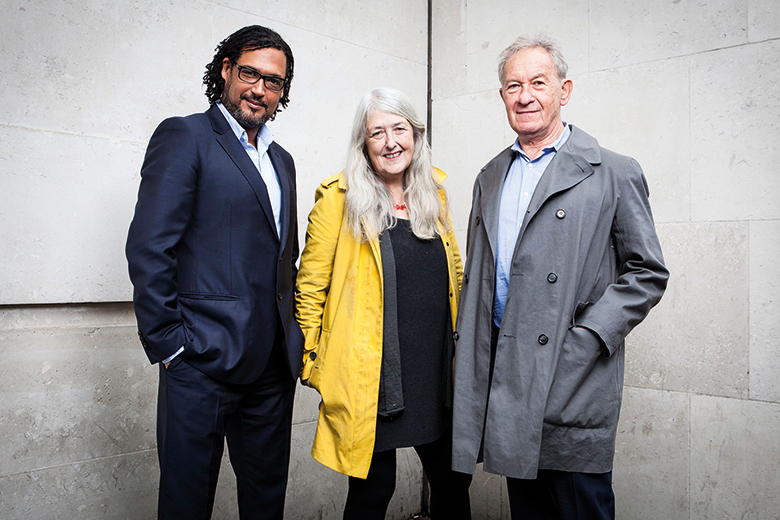On 23 February 1969, Kenneth Clark opened his landmark BBC series Civilisation by admitting that he couldn’t “define [civilisation] in abstract terms – yet. But I think I can recognise it when I see it.”
Although Lord Clark was often mocked for such patrician self-assurance, the art historian’s 13 programmes proved a revelation. Among those who remember them well is Mary Beard, now professor of Classics at the University of Cambridge, who at the time had only been abroad once, on a family holiday to Belgium. She recalled being thrilled to discover all the famous cultural sites that Lord Clark visited, as well as his broader “arguments about art and culture”.
Simon Schama, university professor of history and art history at Columbia University, remembered Civilisation as “the most spectacular colour television...up to that point colour seemed to have been about outside broadcasts featuring the Queen and the occasional football match”, he said. “It was a ravishing breakthrough.” Even more radical, and still radical today, was the way that the directors were “happy to let the camera just drink in art without anything else going on apart from the music”.
In terms of its impact, Professor Schama believed that Civilisation made a deep impact on public understanding because it “brought home to an incredible number of people…a heroic narrative of the classical heritage and Western culture leading to the Enlightenment and then going slightly downhill from the time of Mozart”.
Such a Eurocentric “heroic narrative” feels far less comfortable today. Even at the time, Lord Clark was widely criticised for his assumptions that “civilisation” was in essence European and included precious few women. (Professor Beard “counted the number of active women in the series – and you don’t get many after the Virgin Mary”.)
As the 50th anniversary of the broadcast approaches, therefore, the BBC will mark the occasion with a new nine-part series titled Civilisations. Presented by Professor Schama, Professor Beard and David Olusoga, a broadcaster and historian of empire, it will screen from 1 March.
Revisiting the earlier programmes now, Professor Beard said that she felt “an admixture of total admiration for them and a feeling my blood might boil at any moment”. Although the new series “obviously has Clark in mind, it’s not a remake of Clark but a dialogue with Clark, a conversation with the earlier series”.
In her own two programmes – on representations of the body and religion and art – Professor Beard was “not desperately scrambling to find some female artists, but constantly gender-aware”.
“Often you can’t find any female artists, though there is a myth saying the first portrait artist was female. You can put women in the picture by finding female observers and female commentators,” she said.
At one point, Professor Beard shows viewers a celebrated ancient sculpture of Venus and notes how it already embodies “the link between a statue of a woman and an assumed male viewer, which has never gone away”. She also points to the way that the long-standing assumption that Greek sculpture represents “a beacon of superior Western civilisation” has acted as “a distorting and sometimes divisive lens” through which Europeans have viewed the rest of the world.
Similarly, Professor Schama’s programme about the Renaissance challenges the centrality of Italy, showing how Rome and Istanbul were competing with each other in the 1550s to build the world’s most impressive dome, and also explores connections and rivalries with Mughal India. Today, he explained, we are “probably more aware of the constant cross-fertilisation and rivalry” between cultures than would ever have occurred to Lord Clark.
So Civilisations can certainly claim to be more diverse in its coverage than Civilisation. But that raises two obvious questions. Given the challenges of compressing the whole of human culture into nine hours, what about the things that the new programmes have had to omit (and which may form the focus of another revisionist series in another 50 years’ time)? And weren’t there dangers for academics in straying well beyond their areas of core expertise?
“An awful lot is going to get left out,” admitted Professor Beard, “but you have to find a way not to be full of guilt and dread about what you haven’t included. The way we worked it out is that [my two programmes] have an argument, what drives them is their argument…You think about what you want to say about the problems of representing God and then choose themes, examples, texts and images, and you choose very good examples to make your point and within that you have a reasonable variety.”
Given the deluge of sexist abuse she has had to put up with, Professor Beard felt that she could “handle” a few raised eyebrows about not being a specialist in Egyptian or pre-Columbian art. But she also believed in the value of “starting from a particular research base in classical art and religion which becomes new when you expand outwards. I had some eye-opening moments, but it starts from some rock-solid classical expertise…The way we’ve put things together makes a bigger story than lining up a row of experts on their own little fields”.
Although “very happy to be corrected if I’ve made a blunder – and it’s inconceivable that I haven’t”, Professor Schama was unconcerned about specialists criticising him for spreading himself too thin: “I’m 73 years old and one of the privileges of moving into what Gore Vidal called ‘the springtime of senility’ is that that kind of thing really doesn’t matter.”
Like Lord Clark, Professor Schama was “not at all shy about the irreducible magic of great art” and is happy to appear excited and moved by the works he describes. In this, he acknowledged, he was at odds with much “overcontextualised” academic writing about the arts: “There’s been an overcorrection – the death of the author, the death of originality, [the notion that] genius is a Romantic invention. Of course it’s not! All you have to do is read [what Giorgio Vasari wrote about Michelangelo]. It is absolutely not a late 18th-century invention.”
Although doubtful whether Civilisations “will move into the cultural bloodstream, particularly in the United States, in the way Clark did”, Professor Schama hoped that it could “have a quieter long-term impact. I’ll be very happy if this sense of connectedness, the wiring between cultures, is seen to unfold, and isn’t just used as the basis for some op-ed piece about the joys of multiculturalism.”
matthew.reisz@timeshighereducation.com

Show’s impact still felt after five decades
Kenneth Clark’s 13-part BBC television series Civilisation (1969) focused on European art and thought from the Dark Ages to roughly the end of the 19th century.
Helen Wheatley, reader in film and television studies at the University of Warwick, still regularly shows it to students on her television history and criticism module. Its significance, in her view, is twofold.
As “the first big, expensive, long-ranging documentary series to be shown in colour”, she explained, it offered “a rather dazzling spectacle…and close-up access to some of the world’s finest, most historically significant paintings, sculptures, buildings and so on”. It also “cemented Clark’s position as an educator of the masses…his belief that his audience would be able to come with him on this journey and to follow the sometimes complex ideas he discusses, and his refusal to speak down to the audience, is striking”. It also marked a notable departure from the style of “his televisual predecessor, [the historian] A. J. P. Taylor, who would deliver a lecture straight to camera in a TV studio”.
Three years on from Civilisation, Lord Clark’s view of the world was directly challenged in another BBC television series, John Berger’s four-part Ways of Seeing, which explored the hidden ideologies, particularly around sex and social status, to be found in much art.
In an age when “we’re more used to dazzling HD montage sequences of objects and places as standard” in history programmes, Dr Wheatley was sceptical whether Civilisations would “have the aesthetic impact” of its predecessor. Yet she welcomed the attempt to “address the failings of Clark’s narrative” and had no doubt that it too would be “extremely useful for [her] teaching”.
POSTSCRIPT:
Print headline: Beard and Schama give ‘Civilisation’ a 50-year makeover
Register to continue
Why register?
- Registration is free and only takes a moment
- Once registered, you can read 3 articles a month
- Sign up for our newsletter
Subscribe
Or subscribe for unlimited access to:
- Unlimited access to news, views, insights & reviews
- Digital editions
- Digital access to THE’s university and college rankings analysis
Already registered or a current subscriber?







